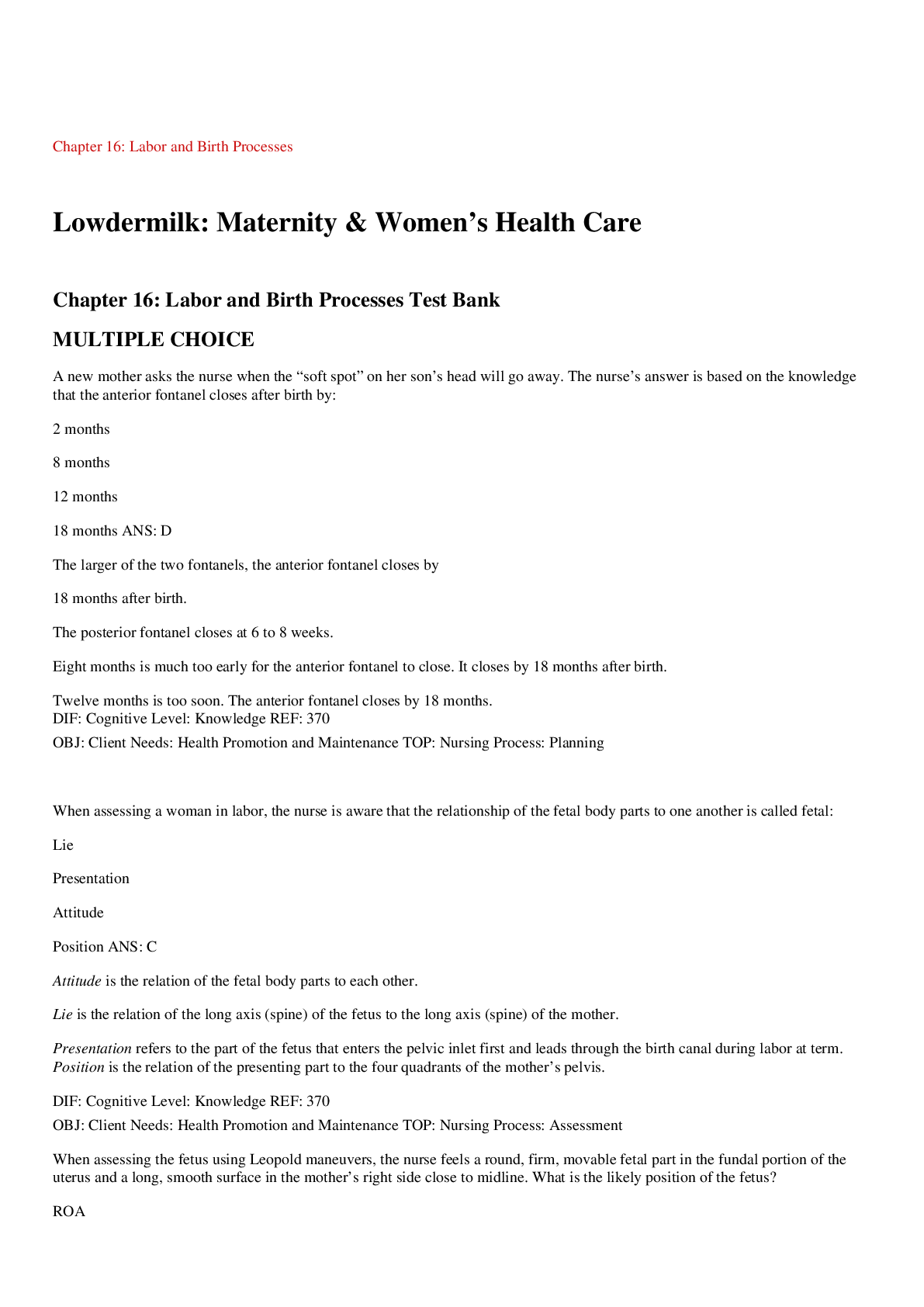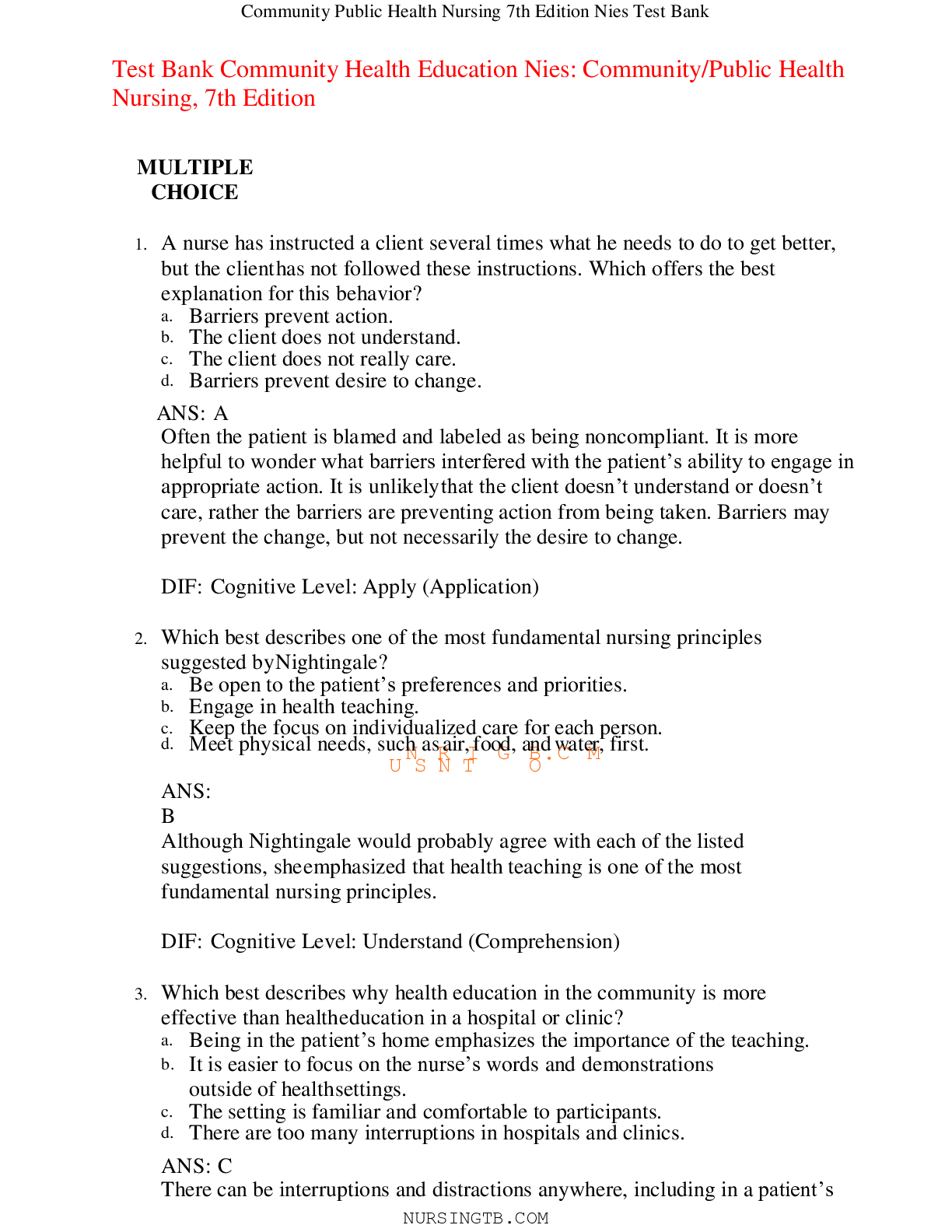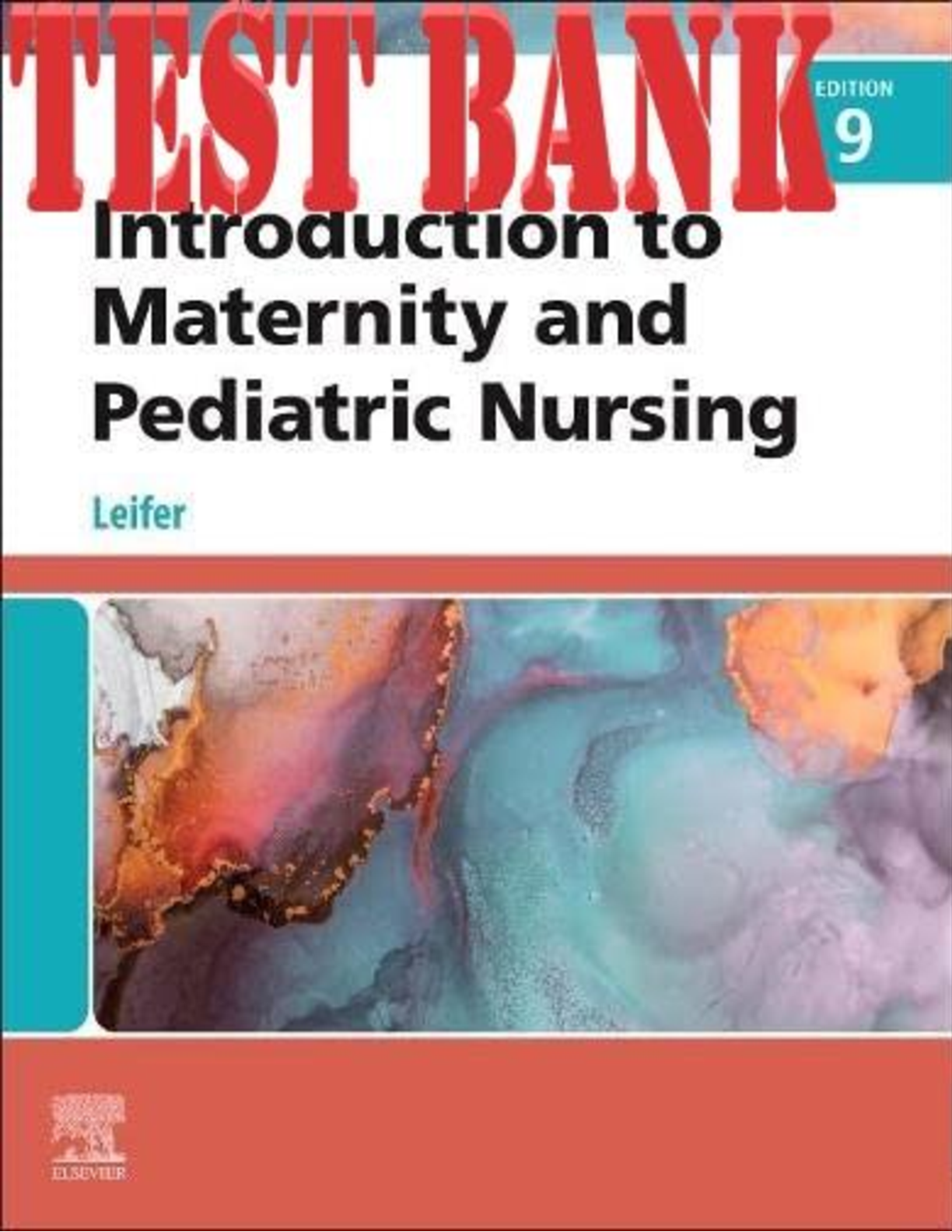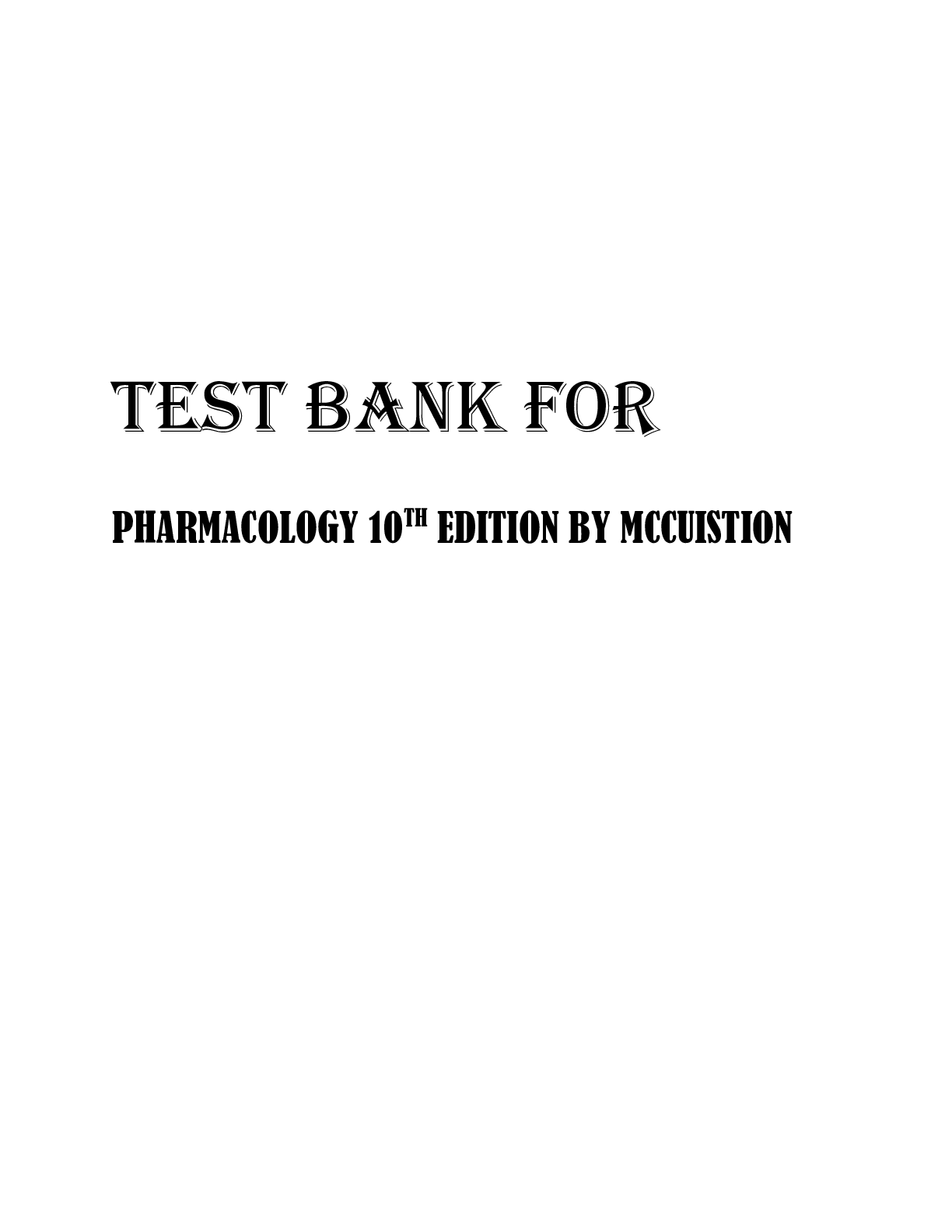*NURSING > TEST BANKS > Test Bank - Introduction to Maternity and Pediatric Nursing 8e (by Leifer) The Childs Experience of (All)
Test Bank - Introduction to Maternity and Pediatric Nursing 8e (by Leifer) The Childs Experience of Hospitalization,100% CORRECT
Document Content and Description Below
Test Bank - Introduction to Maternity and Pediatric Nursing 8e (by Leifer) The Childs Experience of Hospitalization MULTIPLE CHOICE 1. Which child would have the most difficulty in coping with sep... aration from parents because of hospitalization? a. 3-month-old child b. 16-month-old child c. 4-year-old child d. 7-year-old child ANS: B Separation anxiety occurs after age 6 months and is most pronounced in the toddler. DIF: Cognitive Level: Comprehension REF: Page 481 OBJ: 3 TOP: Separation Anxiety KEY: Nursing Process Step: Data Collection MSC: NCLEX: Psychosocial Integrity: Psychosocial Adaptation 2. A 2-year-old child has been crying constantly for his mother since he was hospitalized 3 days ago. What does this behavior suggest? a. The toddler feels abandoned by his mother. b. The child still has not adjusted to his hospitalization. c. The child is not separated from his mother often. d. There is a poor mother-child bond. ANS: A Unless toddlers are extremely ill, their grief and sense of abandonment during hospitalization are obvious. DIF: Cognitive Level: Analysis REF: Page 48N1URSINGTB.COM OBJ: 3 TOP: Separation Anxiety KEY: Nursing Process Step: Data Collection MSC: NCLEX: Psychosocial Integrity: Psychosocial Adaptation 3. Which statement best corresponds to a preschoolers understanding of hospitalization? a. A germ made me get sick. b. I got sick because I was mad at my brother. c. My tonsils are sick and they have to come out. d. I have a cast because I broke my leg. ANS: B The preschooler may feel guilty, particularly if an accident happens as a result of mischief on his or her part. DIF: Cognitive Level: Application REF: Page 491 TOP: The Hospitalized Preschooler KEY: Nursing Process Step: Data Collection MSC: NCLEX: Psychosocial Integrity: Psychosocial Adaptation 4. The parents of a hospitalized toddler are upset because she seems more interested in her toys when they come to visit her. In which stage of separation anxiety is the toddler? a. Protest b. Despair c. Denial d. Attachment ANS: C In the stage of denial or detachment, the child appears to deny the need for the parents and becomes uninterested in their visits. DIF: Cognitive Level: Comprehension REF: Page 481 OBJ: 3 TOP: Separation Anxiety KEY: Nursing Process Step: Data Collection MSC: NCLEX: Psychosocial Integrity: Psychosocial Adaptation 5. The nurse must make a room assignment for a 16-year-old with cystic fibrosis. Which roommate would be the most appropriate for this patient? a. A 4-year-old child who had an appendectomy b. A 10-year-old child with sickle cell disease in vaso-occlusive crisis c. A 15-year-old with type 1 diabetes mellitus d. To assign the adolescent to a private room ANS: C Adolescents usually do better in rooms with one or more roommates than in single rooms. The adolescent would do best with a roommate who is closest to his or her age and also lives with a chronic illness. DIF: Cognitive Level: Application REF: Page 493 TOP: The Hospitalized Adolescent KEY: Nursing Process Step: Planning MSC: NCLEX: Psychosocial Integrity: Psychosocial Adaptation 6. The parents of a hospitalized 9-month-old infant ask if their preschool child may visit his younger sibling. What understanding would assist the nurse most in formulating a response? a. Preschool children can be disruptive in the hospital environment. b. Seeing his younger sibling would probably frighten the preschooler and thus should be avoided. c. The sibling could view the infant from the doorway but not enter the room to prevent the spread of microorganisms. d. The preschooler needs to visit his infant sister to reassure himself that she is all right. ANS: D Siblings are affected by a childs hospitalization. Their ability to cope is influenced by their age, experience, and intactness of the family. NURSINGTB.COM DIF: Cognitive Level: Application REF: Page 487 TOP: SiblingsParents Reaction to Hospitalization KEY: Nursing Process Step: Data Collection MSC: NCLEX: Psychosocial Integrity: Psychosocial Adaptation 7. A hospitalized toddler was drinking from a cup at home but now refuses to drink from anything except his favorite bottle. What is the most likely reason for this behavior? a. He is dealing with the anxiety of hospitalization by regressing. b. He is demonstrating attention-seeking behaviors because of an overabundance of attention in the hospital. c. He is attempting to refocus the attention of the adults around him to avoid further painful procedures. d. He is exhibiting normal behavior for his age, as children often stop new behaviors after they believe they have mastered them. ANS: A Hospitalization is frustrating for toddlers. They show their displeasure when illness restricts satisfaction of their desires. It is not unusual for a toddler who was drinking from a cup to refuse it in the hospital. DIF: Cognitive Level: Comprehension REF: Page 484 OBJ: 1 TOP: Regression KEY: Nursing Process Step: Data Collection MSC: NCLEX: Psychosocial Integrity: Psychosocial Adaptation 8. A nurse encourages a school-age child to draw a picture after a painful procedure. What is the best rationale for this nursing intervention? a. Attempting to re-establish rapport b. Providing a way for the child to express his feelings c. Encouraging quiet play d. Distracting the child from thinking about the pain ANS: B After treatments, the nurse should encourage children to draw and talk about their drawings or to act out their feelings through puppet play. DIF: Cognitive Level: Comprehension REF: Page 492 TOP: The Hospitalized School-Age Child KEY: Nursing Process Step: Implementation MSC: NCLEX: Psychosocial Integrity: Psychosocial Adaptation 9. What is the best suggestion by the nurse when parents ask, When is the best time to begin to prepare a 5- year-old for surgery and hospitalization? a. As soon as the surgery is scheduled b. About 2 weeks before surgery c. About 4 days before surgery d. On the night before admission to the hospital ANS: C Parents should prepare children for procedures and hospitalization a few days in advance. DIF: Cognitive Level: Application REF: Page 487 TOP: The Nurses Role in Hospital AdmissionPreparing the Child KEY: Nursing Process Step: Implementation MSC: NCLEX: Psychosocial Integrity: Psychosocial Adaptation 10. The mother of a 3-year-old tells the nurse that she will be in to visit tomorrow around 12:00 PM. The next morning, the child asks the nurse, When is my mommy coming? What is the nurses best response? a. Your mommy will be here around noon. b. Your mommy will be here when you have lunch. c. Mommy will be here very soon. d. Your mommy is coming in 4 hours. ANS: B NURSINGTB.COM The toddler and preschooler do not understand time yet. They understand time relationships through activities in their experience, such as naptime and mealtimes. DIF: Cognitive Level: Application REF: Page 489 OBJ: 10 TOP: The Hospitalized Toddler/Preschooler KEY: Nursing Process Step: Implementation MSC: NCLEX: Psychosocial Integrity: Psychosocial Adaptation 11. A 13-year-old girl has been hospitalized for the past week. When discussing the girls feelings about her illness, what would the nurse expect the girl to express as her biggest concern? a. Invasive procedures b. Loss of control c. Appearance d. Separation from her boyfriend ANS: C Illness during early adolescence (12 to 15 years) is seen mainly as a threat to body image. DIF: Cognitive Level: Comprehension REF: Page 492 TOP: The Hospitalized Adolescent KEY: Nursing Process Step: Implementation MSC: NCLEX: Psychosocial Integrity: Psychosocial Adaptation 12. The nurse notices that the mother of a child with cerebral palsy corrects and redoes many of the things the nurse does for her child. What is the nurses most appropriate response to this mother? a. Would you like to do all of your childs care? b. Im doing the very best job that I can with your child. c. Why dont you go have a cup of coffee? You are going to be exhausted if you dont take a break. d. Id love for you to share with me some of the special things you do for your child. ANS: D The person who cares daily for the child with a chronic illness can provide information that will best guarantee continuity of care between the home and the hospital. DIF: Cognitive Level: Application REF: Page 486 OBJ: 5 TOP: The Parents Reaction KEY: Nursing Process Step: Implementation MSC: NCLEX: Psychosocial Integrity: Psychosocial Adaptation 13. The mother of a hospitalized toddler states, He cries when I visit. Maybe I should just stay away. What is the nurses best response? a. Perhaps you are right. He only gets upset when you have to leave. b. It is important that you are here. This is a common reaction in children when they are separated from their parents. c. It might be easier for your child if you would stay with him, but this decision is up to you. d. We take good care of him and he seems fine when you are not here. ANS: B During the second stage of separation anxiety (despair), the child is quiet, is not crying, and is sad and depressed. The child will revert to protest when the parent arrives for a visit. DIF: Cognitive Level: Application REF: Page 481 OBJ: 3 TOP: Separation Anxiety KEY: Nursing Process Step: Implementation MSC: NCLEX: Psychosocial Integrity: Psychosocial Adaptation 14. What should the nurse, preparing to collect an admission history from parents who have recently emigrated from Russia, keep in mind? NURSINGTB.COM a. Eye-to-eye contact is considered disrespectful. b. Touching the childs head means the nurse is superior. c. Smiling is inappropriate in a serious situation. d. Staring is a sign of the nurses rudeness. ANS: C In Russia, a smile indicates happiness and is inappropriate in a serious or sad situation. DIF: Cognitive Level: Comprehension REF: Page 486 TOP: Fostering Intercultural Communication KEY: Nursing Process Step: Planning MSC: NCLEX: Psychosocial Integrity: Psychosocial Adaptation 15. Which nursing action would facilitate rapport with a child and the childs parents during the admission process? a. Direct the parents to undress the child. b. Answer questions in a calm and matter-of-fact way. c. Perform assessments and ask questions as quickly as possible. d. Express concern about the seriousness of the childs condition. ANS: B The nurse tries not to appear rushed. A matter-of-fact attitude must be maintained regardless of the childs condition. DIF: Cognitive Level: Application REF: Page 487 OBJ: 5 TOP: Nurses Role in Hospital Admission KEY: Nursing Process Step: Implementation MSC: NCLEX: Psychosocial Integrity: Psychosocial Adaptation 16. When a 2-year-old returns to her hospital room following a diagnostic procedure, her parents are not available, and the child is crying loudly. Which technique is most appropriate to alleviate the childs distress? a. Rock the child gently to sleep. b. Play with the child using pop-up toys. c. Role play with the child to act out her feelings. d. Ask the child to draw a picture about her feelings. ANS: B Distractions such as blowing bubbles, looking through a kaleidoscope, and playing with pop-up toys may help reduce anxiety and pain. DIF: Cognitive Level: Application REF: Page 490 TOP: The Hospitalized Toddler KEY: Nursing Process Step: Implementation MSC: NCLEX: Psychosocial Integrity: Psychosocial Adaptation 17. A 4-year-old begins to cry when his mother tells him it is time for his operation. The nurse understands this is an expected reaction. On which particular fear of the preschooler does the nurse base this understanding? a. Loss of control b. Restricted mobility c. Unfamiliar routines d. Invasive procedures ANS: D The preschool-age child is afraid of bodily harm, particularly invasive procedures. DIF: Cognitive Level: Comprehension REF: Page 491 TOP: The Hospitalized Preschooler KEY: Nursing Process Step: Data Collection MSC: NCLEX: Psychosocial Integrity: Psychosocial Adaptation 18. What statement by the parent of a hospitalNizUedRStoINddGleTrBl.eCaOdsMthe nurse to determine the parent understands a hospitalized toddlers need for transitional objects? a. This stuffed animal makes him feel secure. b. He insisted on bringing this dirty old blanket with him. c. Im going to buy him a big stuffed animal from the gift shop. d. Id like to get him some toys from the playroom. ANS: A The use of a transitional object such as a blanket or a favorite toy promotes security. DIF: Cognitive Level: Application REF: Page 490 TOP: The Hospitalized Toddler KEY: Nursing Process Step: Evaluation MSC: NCLEX: Psychosocial Integrity: Psychosocial Adaptation 19. An 8-year-old child will be hospitalized for several weeks in skeletal traction to treat a fractured femur. What does the nurse realize immobilization in this age-group can generate feelings of in planning care of this child? a. Loss of control b. Altered body image c. Shame and guilt d. Fear of bodily harm ANS: A Forced dependency in the hospital, such as immobilization, can result in a feeling of loss of control and loss of security. DIF: Cognitive Level: Application REF: Page 492 TOP: The Hospitalized School-Age Child KEY: Nursing Process Step: Planning MSC: NCLEX: Psychosocial Integrity: Psychosocial Adaptation 20. The nurse explains to the parents of a hospitalized child that their child will receive fentanyl for an upcoming procedure. What advantage of fentanyl will the nurse explain? a. It is specifically designed for children. b. It has a rapid onset. c. It is nonaddicting. d. It has a long duration. ANS: B Fentanyl is a drug useful for all ages because of its rapid onset and brief duration. DIF: Cognitive Level: Knowledge REF: Page 484 TOP: Fentanyl KEY: Nursing Process Step: Implementation MSC: NCLEX: Physiological Integrity: Pharmacological Therapies 21. The nurse shares the information and timelines recorded on the interdisciplinary outline of care for a child. What is this document? a. Clinical pathway b. Comprehensive nursing care plan c. Holistic care approach d. Incorporated cost analysis ANS: A This document is the clinical pathway, which is a broad outline of interdisciplinary plan of care with specific timelines. DIF: Cognitive Level: Comprehension REF: Page 488 TOP: Clinical Pathway KEY: Nursing Process Step: Implementation MSC: NCLEX: Safe, Effective Care Environment: Coordinated Care 22. The anxious parent asks if there is a dangeNr UofRhSeINr 2G-TyBea.Cr-OolMd child becoming addicted to the opioid pain reliever. What is the nurses most helpful response? a. Although this drug is addictive, the doctor monitors the dose very carefully. b. Dont worry. Addicted children are very easy to wean off the drug. c. Addiction is rare in children when opiates are given for pain. d. Addictive behaviors are easy to assess. The drug will be stopped if that happens. ANS: C Addiction is rare in children. DIF: Cognitive Level: Comprehension REF: Page 484 TOP: Pain Relief KEY: Nursing Process Step: Intervention MSC: NCLEX: Physiological Integrity: Pharmacological Therapies 23. The nurse is preparing to start an IV on an infant admitted to the pediatric unit. What intervention is appropriate for the nurse to implement? a. Involve the parents. b. Provide a simple explanation to the child. c. Let the child examine the equipment. d. Suggest coping techniques. ANS: A It is appropriate to involve the parents when performing a procedure on an infant. Providng a simple explanation, letting the child examine the equipment, and suggesting coping techniques are not appropriate interventions for an infant. DIF: Cognitive Level: Application REF: Page 480 OBJ: 7 TOP: Age-Appropriate Interventions KEY: Nursing Process Step: Implementation MSC: NCLEX: Physiological Integrity: Basic Care and Comfort 24. The pediatric nurse is caring for child that weighs 15 kilograms and calls the physician for an order for Acetaminophen for pain control. What is the maximum amount of medication per dose the nurse anticipates ordering? a. 100 mg b. 150 mg c. 225 mg d. 250 mg ANS: C Acetaminophen is commonly used for the relief of mild to moderate pain in infants and children. The maximum dose is 15 mg/kg/dose for infants and children, with a maximum of 5 doses in 24 hours. DIF: Cognitive Level: Analysis REF: Page 484 TOP: Age-Appropriate Interventions KEY: Nursing Process Step: Planning MSC: NCLEX: Physiological Integrity: Pharmacological Therapies MULTIPLE RESPONSE 25. What will the nurse include when documenting the discharge of a pediatric patient? (Select all that apply.) a. Time of discharge b. Adult(s) accompanying the child and the relationship to the child c. Condition of the child d. Method of transportation e. Instructions that were given to physician ANS: A, B, C, D Information that should be included in the discharge note include time of discharge, adults accompanying the child and relationship to child, condition of the child, and method of transportation. It should also be documented that instructions were given to parents. NURSINGTB.COM DIF: Cognitive Level: Application REF: Page 494 OBJ: 12 TOP: Discharge Documentation KEY: Nursing Process Step: Implementation MSC: NCLEX: Safe, Effective Care Environment: Coordinated Care 26. The nurse suggests to parents that they use the outpatient surgical center for their childs upcoming surgery. What advantage(s) does this type of facility have to offer? (Select all that apply.) a. Lower cost b. Less incidence of health careassociated infections c. Reduction of parent-child separation d. Ample time for recuperation at the facility e. Decreased emotional impact of illness ANS: A, B, C, E All options listed are advantages of outpatient services with the exception of recuperating at the facility. DIF: Cognitive Level: Comprehension REF: Page 479 OBJ: 2 TOP: Outpatient Facilities KEY: Nursing Process Step: Implementation MSC: NCLEX: Psychosocial Integrity: Psychosocial Adaptation 27. What are the basic fears of a young child being hospitalized? (Select all that apply.) a. Separation b. Permanent scarring c. Pain d. Cost e. Body intrusion ANS: A, C, E Small children all share the same basic fears relative to hospitalization, which are separation from family, pain, and body intrusion or mutilation. DIF: Cognitive Level: Comprehension REF: Page 481 TOP: Basic Fear KEY: Nursing Process Step: Data Collection MSC: NCLEX: Psychosocial Integrity: Psychosocial Adaptation 28. What information will the nurse include when taking a developmental history? (Select all that apply.) a. Previous experience with hospitalization b. Cultural needs c. History of illness d. Allergies e. Childs nickname ANS: A, B, E The developmental history has information about the child and the childs developmental and cultural needs and personal preferences. The information relative to history of illness or allergies would be covered in the medical history. DIF: Cognitive Level: Application REF: Page 488 TOP: Developmental History KEY: Nursing Process Step: Data Collection MSC: NCLEX: Psychosocial Integrity: Psychosocial Adaptation 29. The nurse is preparing to obtain a throat culture on a toddler patient. What interventions are appropriate for the nurse to implement? (Select all that apply.) a. Model desired behavior. b. Instruct patient not to yell. c. Use distractions. d. Explain the procedure in detail. e. Encourage the child to ask questions. ANS: A, C NURSINGTB.COM Whenever possible the parent should be involved in the preparation for and initiation of a treatment or procedure, and the child should be prepared according to his or her developmental level. For a toddler, model the behavior desired (i.e., opening the mouth), tell the child it is okay to yell if the treatment or procedure is uncomfortable, and use distractions. Explaining the procedure in detail and encouraging questions are appropriate interventions for an older child. DIF: Cognitive Level: Application REF: Page 490 TOP: Promoting a Positive Experience KEY: Nursing Process Step: Intervention MSC: NCLEX: Psychosocial Integrity: Psychosocial Adaptation 30. Parents are preparing their child for admission to the pediatric unit for minor surgery. What should they expect to see when visiting the pediatric unit? (Select all that apply.) a. Nurses wearing all white b. Formal atmosphere c. Availability of a playroom d. Dim lighting e. Colored bedding ANS: C, E The childrens hospital unit differs in many respects from adult divisions. The pediatric unit or hospital is designed to meet the needs of children and their parents. A cheerful, casual atmosphere helps to bridge the gap between home and hospital and is in keeping with the childs emotional, developmental, and physical needs. Nurses wear colorful uniforms, and colored bedspreads and wagons or strollers for transportation provide a more homelike atmosphere. The physical structure of the unit includes furniture of the proper height for the child, soundproof ceilings, and color schemes with eye appeal. Most pediatric departments include a playroom. DIF: Cognitive Level: Knowledge REF: Page 480 OBJ: 2 TOP: Health Care Delivery Settings/Pediatric Unit KEY: Nursing Process Step: Planning MSC: NCLEX: Safe, Effective Care Environment: Coordinated Care COMPLETION 31. When the preschooler who is hospitalized for surgery to correct a poorly healed fracture says, My doctor is going to unscrew my bent arm and screw on a new one, the nurse should this misconception. ANS: correct All misconceptions that a youngster has about procedures should be corrected. DIF: Cognitive Level: Knowledge REF: Page 491 TOP: Misconceptions KEY: Nursing Process Step: Implementation MSC: NCLEX: Psychosocial Integrity: Psychosocial Adaptation 32. A(n) is a person under the age of 18 who can legally sign for consent for medical treatment for themselves or their children. ANS: emancipated minor A person under the age of 18 who is no longer under the care of his parents authority or a married minor or minors in the military are considered emancipated minors who are accorded the rights of an adult. DIF: Cognitive Level: Knowledge REF: Page 493 TOP: Emancipated Minor KEY: Nursing Process Step: N/A MSC: NCLEX: Safe, Effective Care EnvironmNeUnRt:SCINoGorTdBin.CatOedMCare 33. provides trained workers who come into the home for brief periods to relieve parents of the responsibility of caring for the child. ANS: Respite care Respite care provides trained workers who come into the home for brief periods to relieve parents of the responsibility of caring for the child. DIF: Cognitive Level: Knowledge REF: Page 494 TOP: Respite Care KEY: Nursing Process Step: N/A MSC: NCLEX: Safe, Effective Care Environment: Coordinated Care [Show More]
Last updated: 2 years ago
Preview 1 out of 18 pages

Buy this document to get the full access instantly
Instant Download Access after purchase
Buy NowInstant download
We Accept:

Reviews( 0 )
$17.00
Can't find what you want? Try our AI powered Search
Document information
Connected school, study & course
About the document
Uploaded On
Jul 14, 2022
Number of pages
18
Written in
Additional information
This document has been written for:
Uploaded
Jul 14, 2022
Downloads
0
Views
94


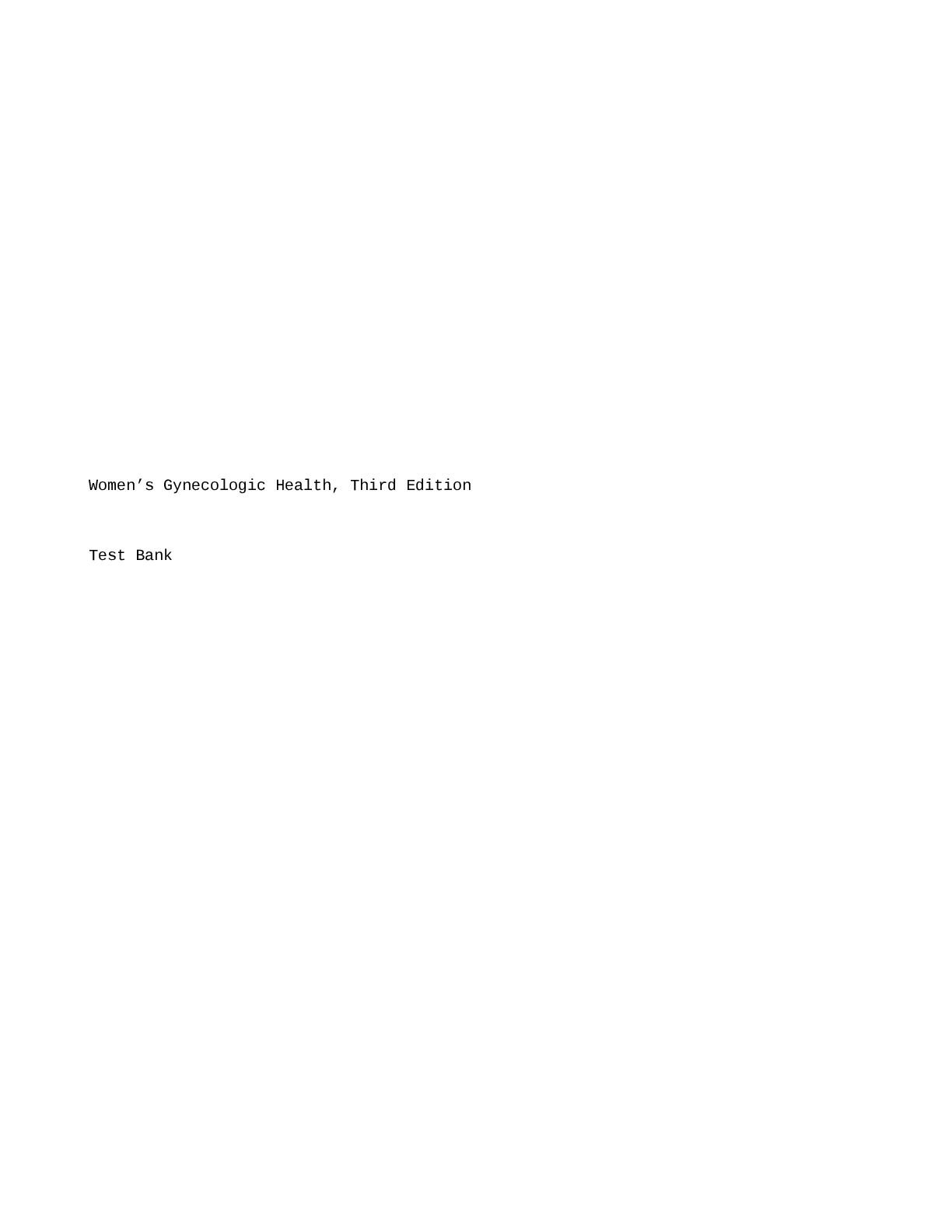

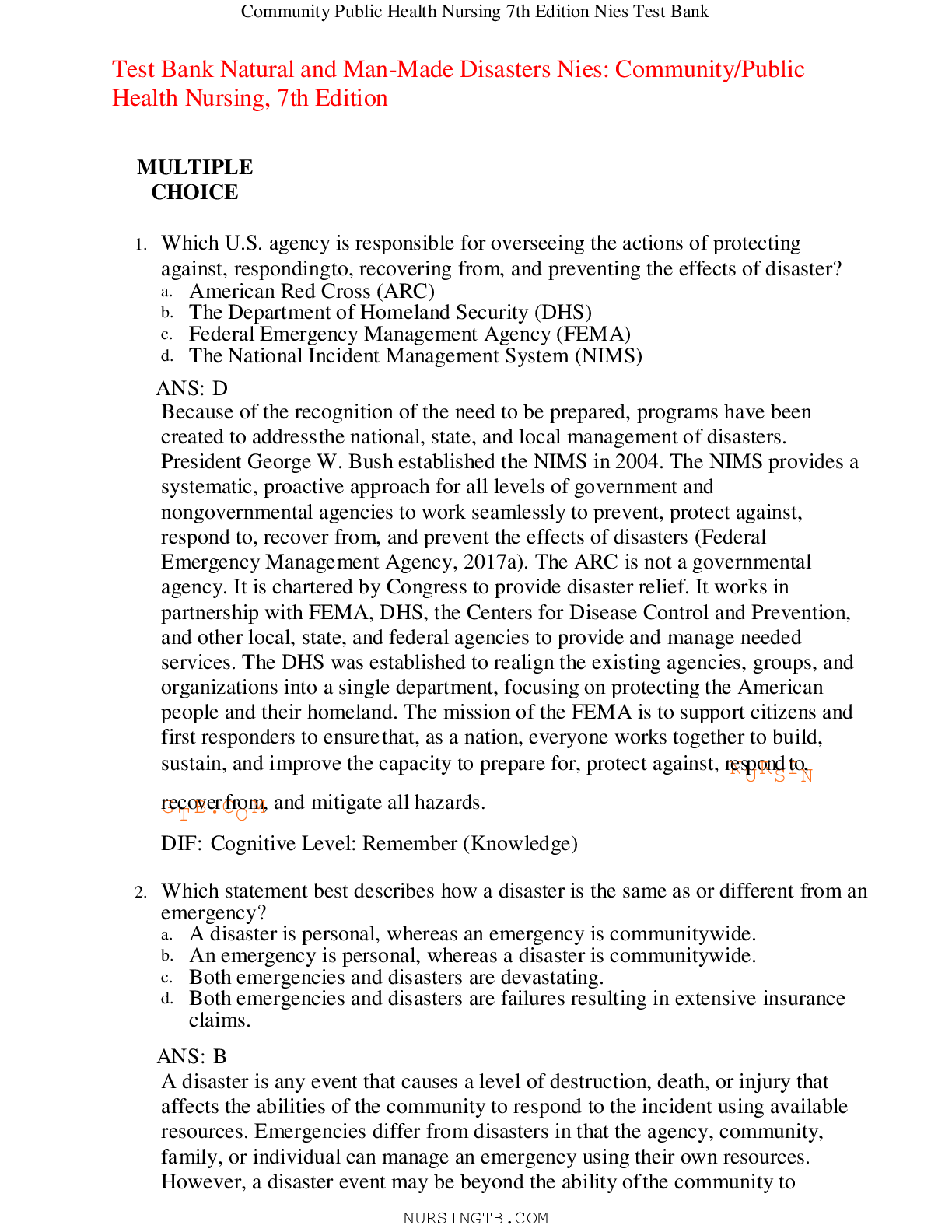

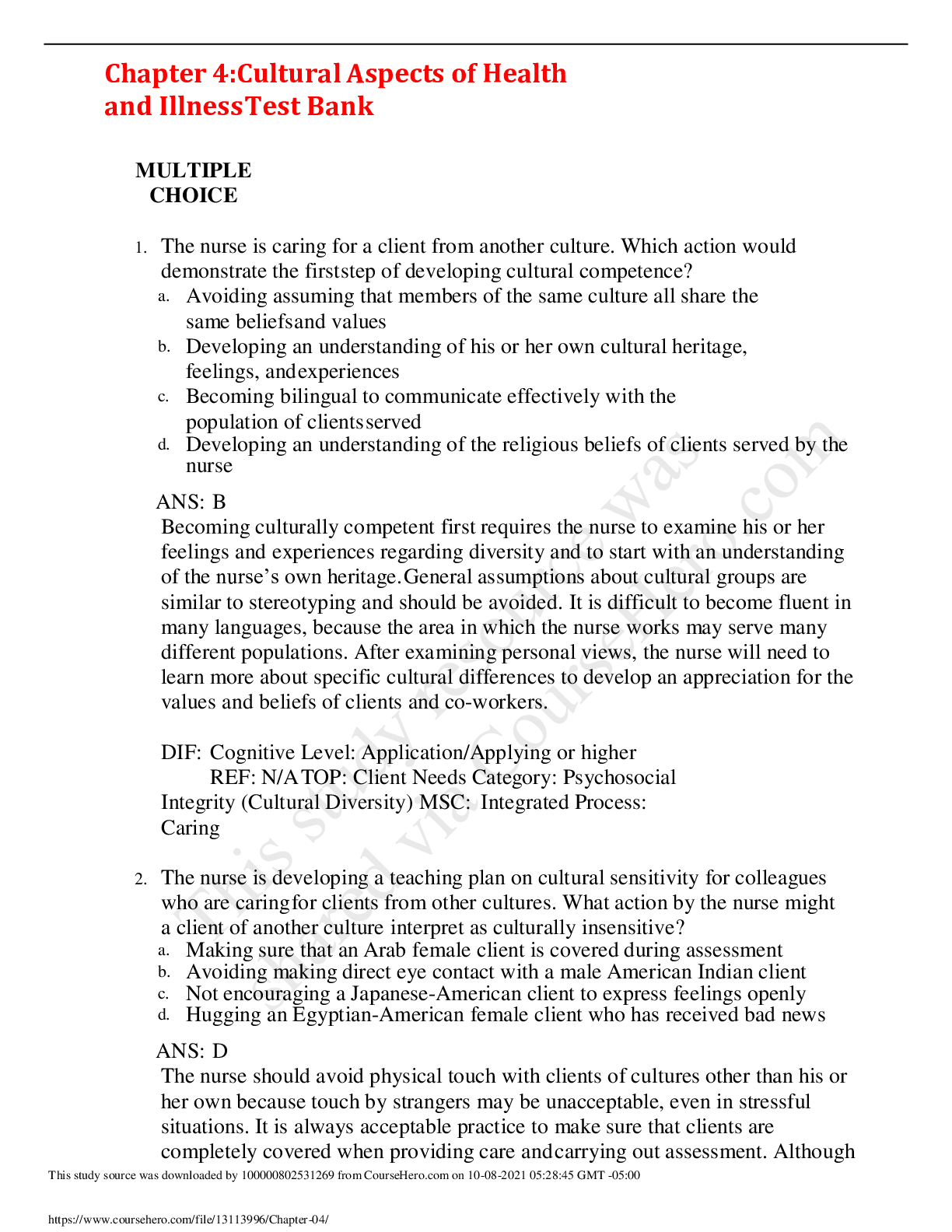


.png)
